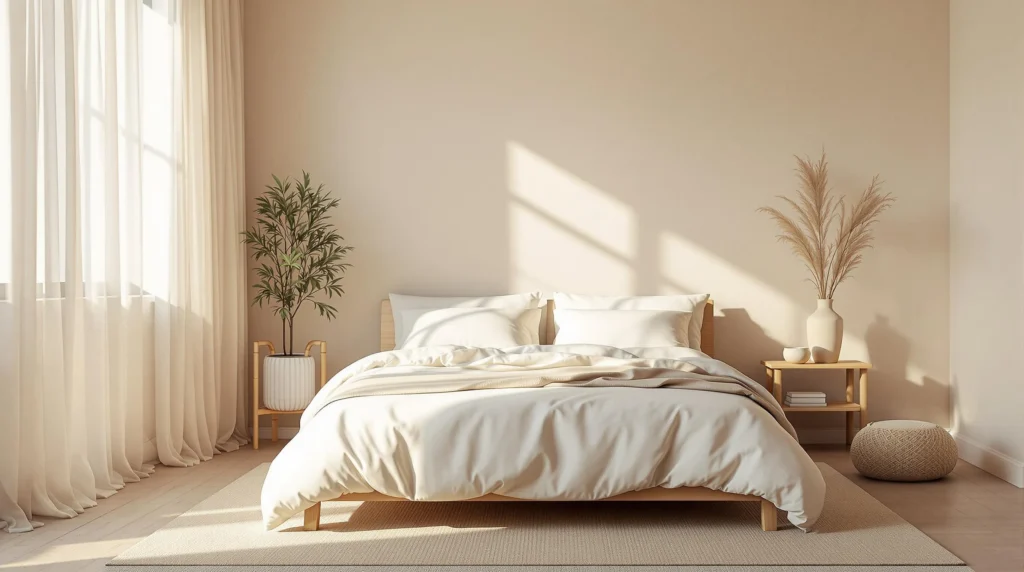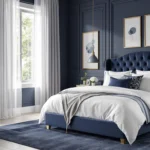Creating the perfect minimalist bedroom starts with choosing the right colors. We understand that finding the balance between simplicity and style can be challenging, especially when you’re aiming for that clean, uncluttered aesthetic that minimalism demands.
In our experience, the best colors for minimalist spaces aren’t just about following trends—they’re about creating a peaceful sanctuary that reflects your personal style while maintaining clean lines and visual calm. We’ve researched and tested many color palettes to bring you the most effective options that will transform your bedroom into a minimalist haven without feeling cold or impersonal.
Best Neutral Colors for a Minimalist Bedroom Design
Classic White
White remains the quintessential minimalist color choice for bedrooms, offering unmatched versatility and brightness. We’ve found that pure whites like Benjamin Moore’s “White Dove” or Sherwin Williams’ “Alabaster” create an instantly calming atmosphere that feels open and airy. These whites serve as perfect backdrops for natural textures and simple furniture pieces without overwhelming the senses. Rooms painted in crisp white help better light reflection, making spaces appear larger and more expansive—ideal for smaller bedrooms with limited natural light.
Soft Beige
Beige tones bring warmth to minimalist spaces while maintaining the clean aesthetic essential to minimalist design. Our experiments with colors like Behr’s “Toasty Gray” and Farrow & Ball’s “Joa’s White” revealed how these soft beiges add subtle dimension without sacrificing simplicity. These hues pair beautifully with natural wood elements, linen textiles, and stone accents that define modern minimalism. Beiges with slight yellow undertones create a cozy, inviting atmosphere that pure whites sometimes lack.
Warm Gray
Gray has evolved from a trendy choice to a minimalist staple, offering sophistication without visual complexity. We recommend lighter grays with warm undertones like Sherwin Williams’ “Repose Gray” or Benjamin Moore’s “Balboa Mist” for serene bedroom spaces. These versatile grays complement virtually any accent color or material, from brass fixtures to walnut furniture. Gray walls provide an excellent neutral foundation that allows architectural details and carefully selected furnishings to stand out.
Greige
Greige—the perfect marriage of gray and beige—delivers the best of both worlds for minimalist bedrooms seeking balance. Our testing confirms that colors like Sherwin Williams’ “Agreeable Gray” and Benjamin Moore’s “Revere Pewter” create sophisticated backdrops that feel neither too cool nor too warm. These adaptable neutrals shift subtly throughout the day as lighting changes, adding visual interest without disrupting the minimalist aesthetic. Greige works particularly well in north-facing rooms that need warmth without sacrificing the clean minimalist look.
Soft Black
For those seeking dramatic minimalism, soft blacks create striking statement walls without overwhelming the space. We’ve successfully used Farrow & Ball’s “Railings” and Benjamin Moore’s “Wrought Iron” to add depth while maintaining minimalist principles. These near-blacks pair beautifully with crisp white trim and natural materials for high-contrast minimalism that feels intentional rather than stark. Soft blacks work particularly well on accent walls or in well-lit rooms where they won’t make the space feel confined.
Pale Taupe
Taupe offers subtle warmth while remaining firmly in the neutral category, perfect for minimalist bedrooms that need dimension. Colors like Benjamin Moore’s “Pale Oak” or Sherwin Williams’ “Accessible Beige” provide nuanced backdrops that complement natural fibers and organic textures. These understated hues create calming environments that feel grounded and timeless rather than trendy. Taupe walls pair exceptionally well with white bedding and natural wood furniture for that quintessential minimalist look.
Choosing Pure White for an Effortlessly Clean Look
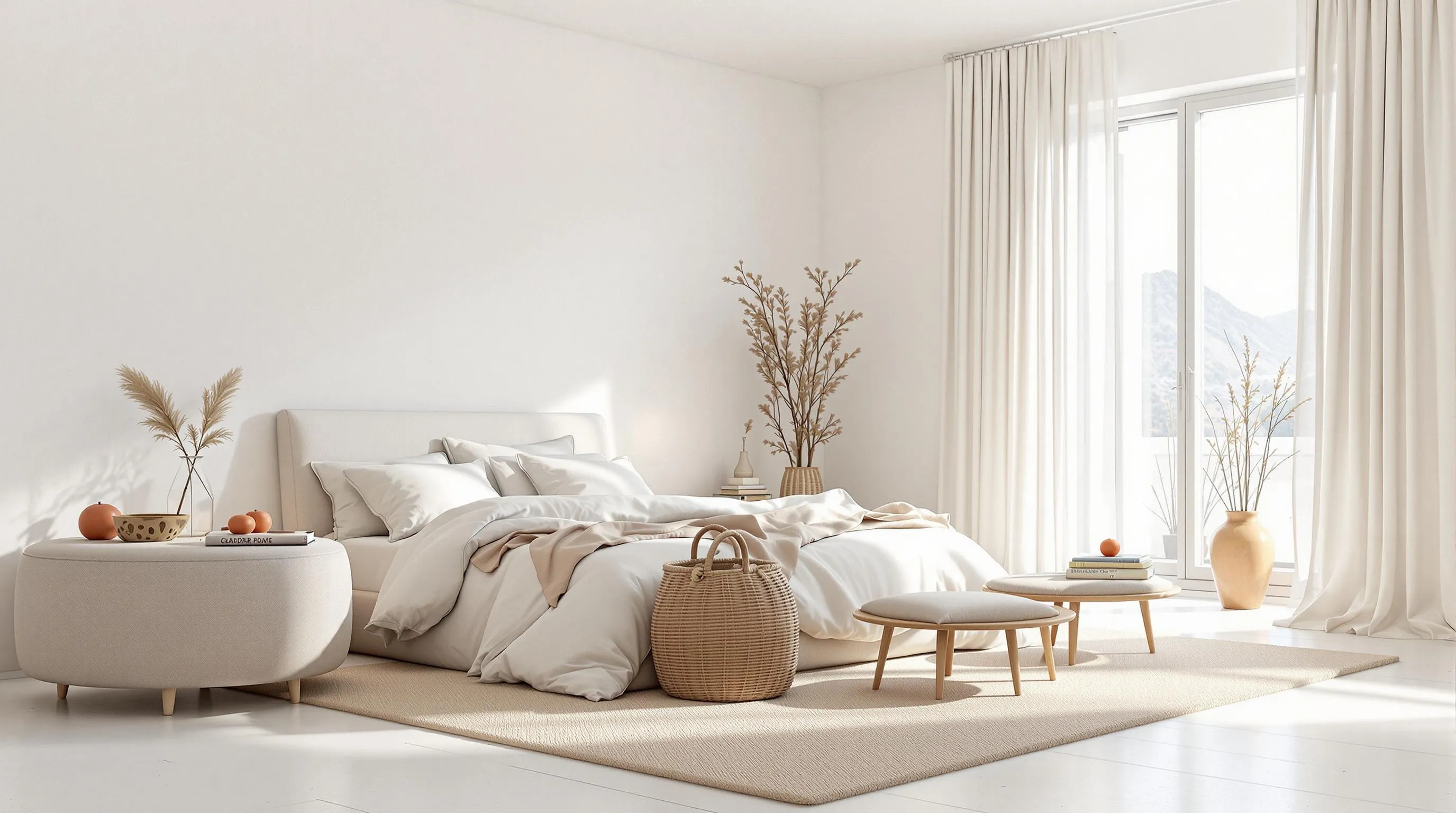
White remains the quintessential choice for minimalist bedroom designs, creating an immediate sense of spaciousness and light. This timeless option serves as the perfect backdrop for a truly minimalist aesthetic while maintaining visual simplicity.
Best White Paint Colors for Minimalist Spaces
Pure, bright whites deliver a stark, airy aesthetic that amplifies natural light throughout your bedroom space. Opt for crisp whites when you want to achieve that classic gallery-like minimalist environment. Off-whites paired with warm wood and terracotta accents create a more modern, inviting feel without compromising minimalist principles. We recommend exploring Japandi-inspired palette options like Beige 02 or Greige 01, which masterfully balance neutrality with subtle earthy undertones. These sophisticated white variations provide enough character to prevent your space from feeling clinical while maintaining the clean lines essential to minimalist design.
How to Add Texture to White Minimalist Bedrooms
Introducing varied textiles prevents white minimalist bedrooms from feeling sterile or flat. Light floor-to-ceiling drapes instantly add vertical interest while maintaining the airy quality of the space. Flat-weave rugs in complementary neutrals ground the room without introducing visual clutter. Upholstered furniture pieces in soft neutral tones create depth through subtle texture variations rather than competing colors. Layer materials strategically throughout the space—consider terracotta decorative elements, warm wood furnishings, or pleated blankets in chocolate brown tones. Natural fibers like linen or wool bedding introduce organic texture that enhances the sensory experience of your minimalist bedroom. Combining matte finishes with these textural elements creates a sophisticated white space that feels both clean and invitingly warm.
Embracing Soft Grays for a Sophisticated Minimalist Aesthetic
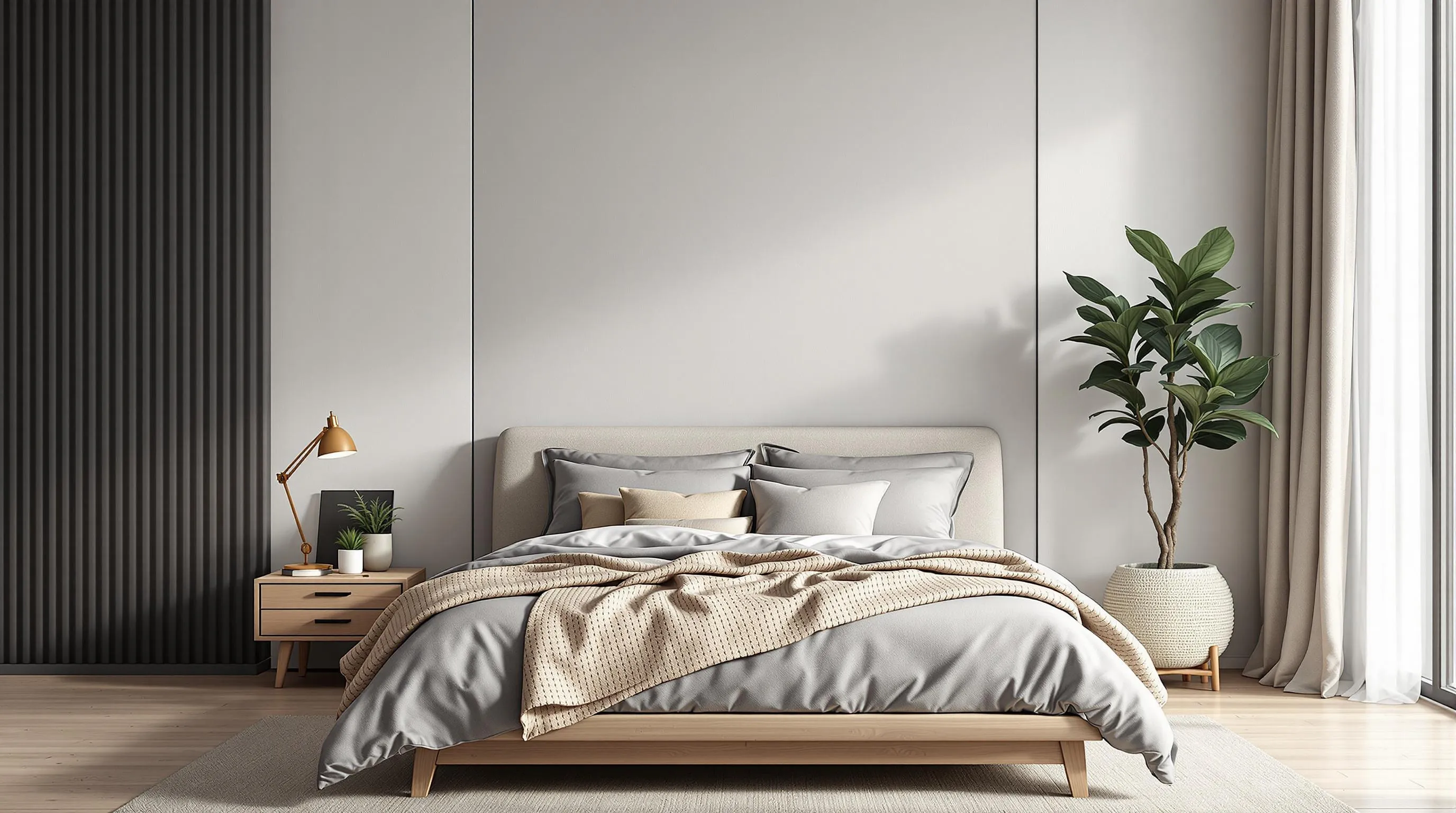
Gray offers remarkable versatility in minimalist bedroom design, ranging from cool blue-toned hues to warm greige tones that create depth and modern sophistication. This neutral cornerstone adds contrast through dark accents while maintaining the clean aesthetic that defines minimalism, especially when paired with natural textures like wood or linen.
Light Gray vs. Dark Gray in Minimalist Design
Light gray amplifies natural light throughout your bedroom, creating an airy atmosphere that feels both spacious and serene. When paired with white or beige elements, light gray establishes a peaceful backdrop that embodies minimalist principles without feeling cold or clinical. The reflective quality of lighter grays helps maximize brightness in smaller bedrooms, making them appear larger and more open.
Dark gray introduces drama and sophistication while anchoring a minimalist space without overwhelming it. These deeper tones work exceptionally well in bedrooms with open layouts and abundant natural light, providing visual weight that balances minimal decor. Dark gray accent walls or furniture pieces create focal points that add dimension to an otherwise understated space, proving that minimalism doesn’t have to lack visual interest.
Complementary Accent Colors for Gray Bedrooms
Warm neutrals like beige, taupe, and terracotta introduce coziness to gray bedrooms while maintaining the harmonious balance essential to minimalist design. These subtle color additions prevent gray spaces from feeling too cool or impersonal. Incorporating these warmer tones through textiles or small accessories adds depth without compromising simplicity.
Muted earth tones such as sage green and dusty blue complement gray beautifully, adding organic depth through carefully selected textiles or artwork. These nature-inspired hues bring a subtle connection to the natural industry, improving the calming effect of a minimalist bedroom. Limiting these accents to just one or two items preserves the uncluttered aesthetic while adding personality.
Monochromatic layering creates sophisticated texture by incorporating various shades of gray throughout the space. This approach utilizes lighter and darker gray tones in bedding, rugs, and decorative elements to build visual interest while maintaining color cohesion. The subtle variations in tone create depth and dimension without introducing competing colors, perfectly aligning with minimalist principles that value intentional simplicity.
Incorporating Warm Beige and Cream Tones for Coziness
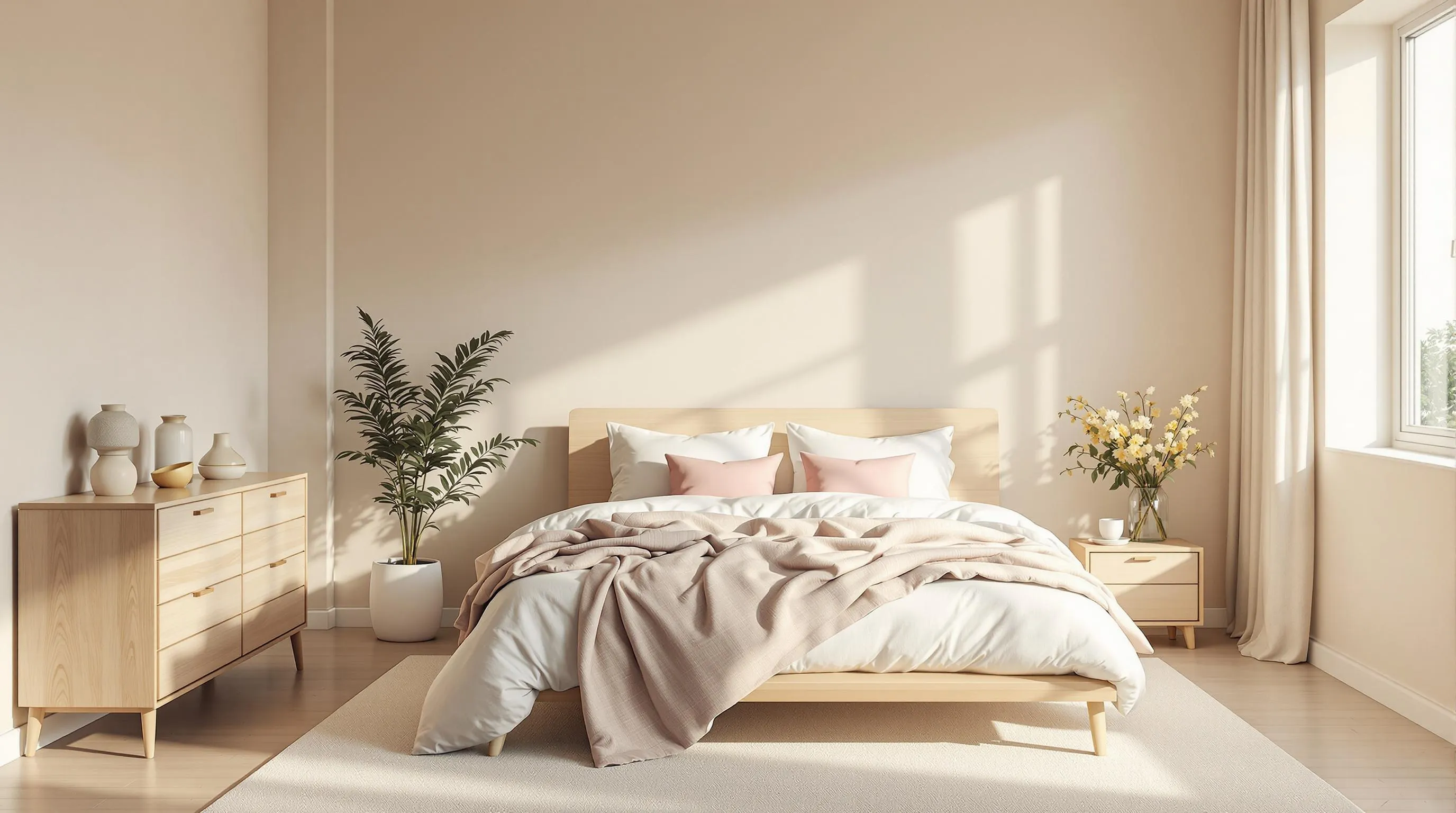
Warm beige and cream tones offer the perfect balance of simplicity and warmth for minimalist bedrooms. These neutral shades create a soothing foundation while maintaining the clean aesthetic that defines minimalist design.
Natural Beige Color Palettes That Enhance Minimalism
Natural beige color palettes serve as the backbone of successful minimalist bedroom designs. These foundational neutrals create an immediate sense of spaciousness and light, allowing the room to breathe visually. Shades of white, gray, and taupe work harmoniously with beige to establish a balanced and serene environment. We’ve found that beige tones applied to walls create an expansive feeling, while furniture in similar neutral shades maintains visual cohesion. The beauty of natural beige lies in its versatility—it pairs effortlessly with different textures and materials without compromising the minimalist principle of simplicity. Many designers opt for a limited palette of pale beige, gold, and white to create depth while still adhering to minimalist aesthetics.
Creating Warmth Without Visual Clutter
Adding warmth to a minimalist bedroom requires thoughtful combination of neutral tones with natural textures. Beige walls paired with warm wood furniture instantly creates coziness without overwhelming the space. Textural elements play a crucial role in this balance—soft area rugs, linen bedding, and knit throws introduce warmth through tactile contrast rather than busy patterns. Introducing subtle color accents like pale blues or blush pinks in small doses can add interest without compromising the clean aesthetic. Wood accents particularly complement beige and cream tones, bringing an organic element that enhances the cozy feel of the space. The key lies in strategic placement of these warming elements—a single wooden bedside table or a small blush accent pillow provides just enough visual interest without cluttering the minimalist foundation.
Adding Subtle Color with Muted Blues and Greens

While neutrals form the foundation of minimalist bedrooms, thoughtfully integrated color can enhance the space without compromising simplicity. Muted blues and greens offer the perfect balance of subtle color and calming energy.
Calming Blue Tones for Minimalist Sanctuaries
Muted blues create an exceptionally tranquil atmosphere in minimalist bedrooms without disrupting the clean aesthetic. Soft powder blues and dusty periwinkles evoke feelings of serenity, making them ideal companions for white or light gray walls. These gentle hues work beautifully as accent colors through bedding, curtains, or a single piece of furniture, allowing you to maintain the minimalist principle of restraint. Many designers recommend pale blue tones specifically because they promote relaxation while complementing the spacious feel that minimalist spaces strive to achieve. For maximum effect, pair these subtle blues with natural textures like linen or cotton to enhance the sensory experience without adding visual clutter.
Organic Green Hues That Support Minimalist Principles
Pale greens bring a natural element into minimalist bedrooms, creating a connection to the outdoors while maintaining design simplicity. Sage, mint, and muted olive tones add depth and character without overwhelming the senses or conflicting with minimalist values. These organic hues particularly shine when incorporated through small accents like throw pillows, artwork, or a single plant, reinforcing the minimalist concept of intentional selection. Natural green tones foster a sense of calm and wellbeing, serving as a gentle reminder of nature within your serene space. For a cohesive look, we recommend pairing these subtle greens with natural wood elements and neutral foundations like white or beige, creating a balanced atmosphere that feels both refreshing and restful.
Working with Earth Tones for a Grounded Minimalist Space
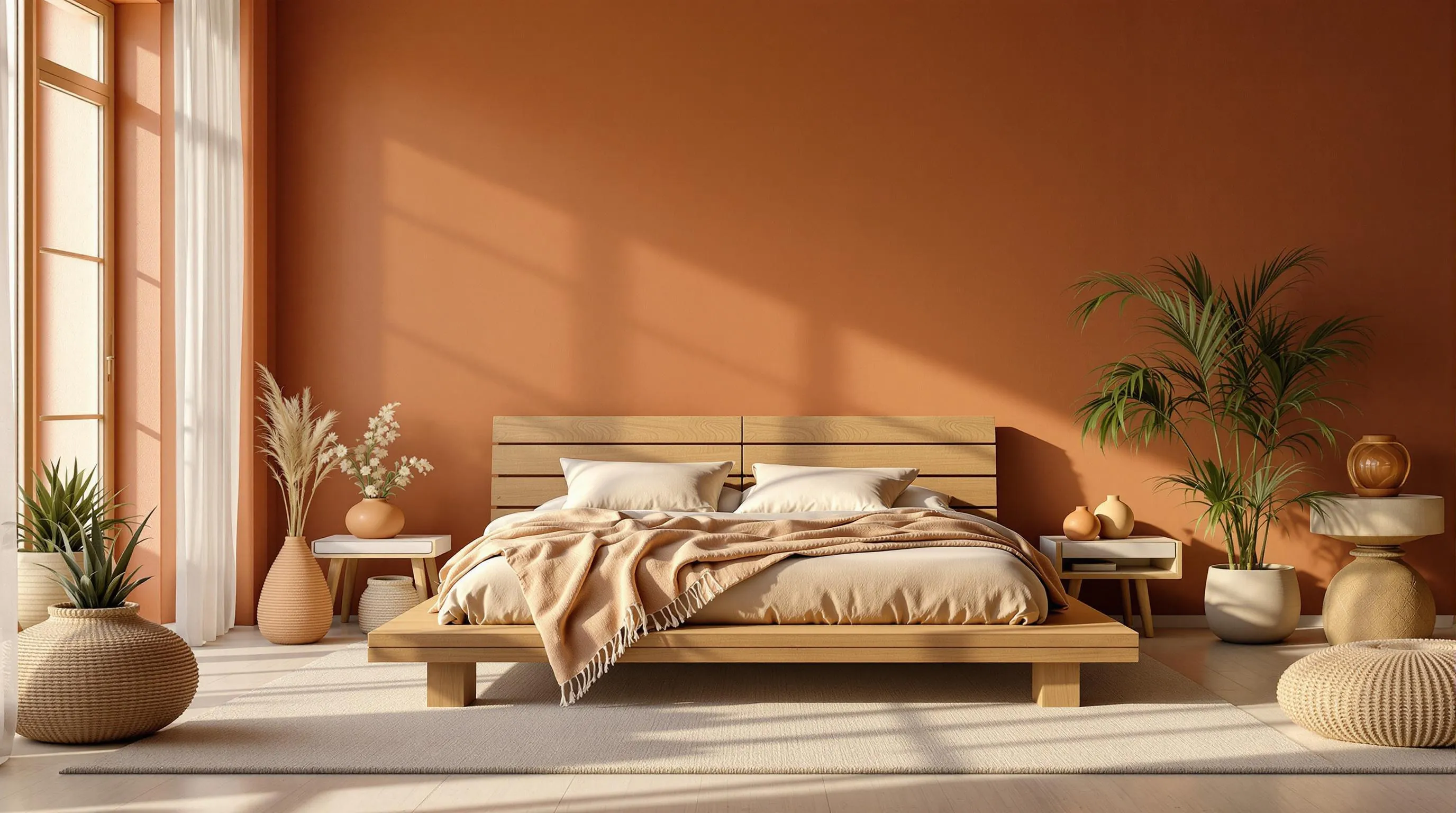
Earth tones offer a perfect balance between warmth and simplicity for minimalist bedrooms, creating spaces that feel both serene and connected to nature. These colors provide a grounded aesthetic while maintaining the clean lines and uncluttered approach essential to minimalist design.
Terracotta and Clay Colors in Modern Minimalism
Terracotta and clay hues introduce organic warmth to minimalist bedrooms without compromising their clean aesthetic. These earthy colors work beautifully when paired with minimalist furniture, creating visual interest while maintaining a sense of calm. Designers like Cathie Hong Interiors effectively demonstrate this approach by combining terracotta accents with off-white tones to create balanced, serene spaces. In monochromatic schemes, these warm earth tones can serve as subtle focal points against neutral backgrounds, adding character without overwhelming the minimalist ethos.
For best results, consider using terracotta as an accent color through textiles, ceramics, or small decorative elements rather than covering large surfaces. Clay tones offer a more subdued alternative that pairs exceptionally well with white walls and natural materials like wood and linen. These combinations honor minimalism’s focus on intentional design while introducing the comforting elements of nature.
Balancing Earth Tones with Minimalist Furniture
Creating harmony between earth tones and minimalist furniture requires thoughtful implementation of several key strategies. Limited color palettes form the foundation of this approach—combining just 2-3 earth tones with neutrals creates cohesive, calming environments. For instance, pairing beige walls with terracotta textiles and black accents delivers visual interest without chaos, as showcased in Gray Space Interior Design’s successful khaki-beige-black combination.
Texture contrast plays an equally important role in balancing these elements. Matte finishes on walls complement natural fiber textiles, adding depth and dimension to the space without relying on busy patterns or bright colors. Clean-lined wooden beds and unadorned shelving units provide perfect companions to earthy walls, supporting the minimalist philosophy without competing for attention.
When selecting furniture to complement earth-toned spaces, prioritize pieces with simple silhouettes and natural materials. A platform bed in light wood works beautifully against terracotta walls, while black metal accents can provide definition in rooms with softer clay tones. Research from Lick emphasizes that successful minimalist color schemes rely more on tonal harmony than chromatic variety, with careful attention to saturation levels preventing earth tones from overwhelming the space.
Creating Contrast with Black Accents in Minimalist Bedrooms
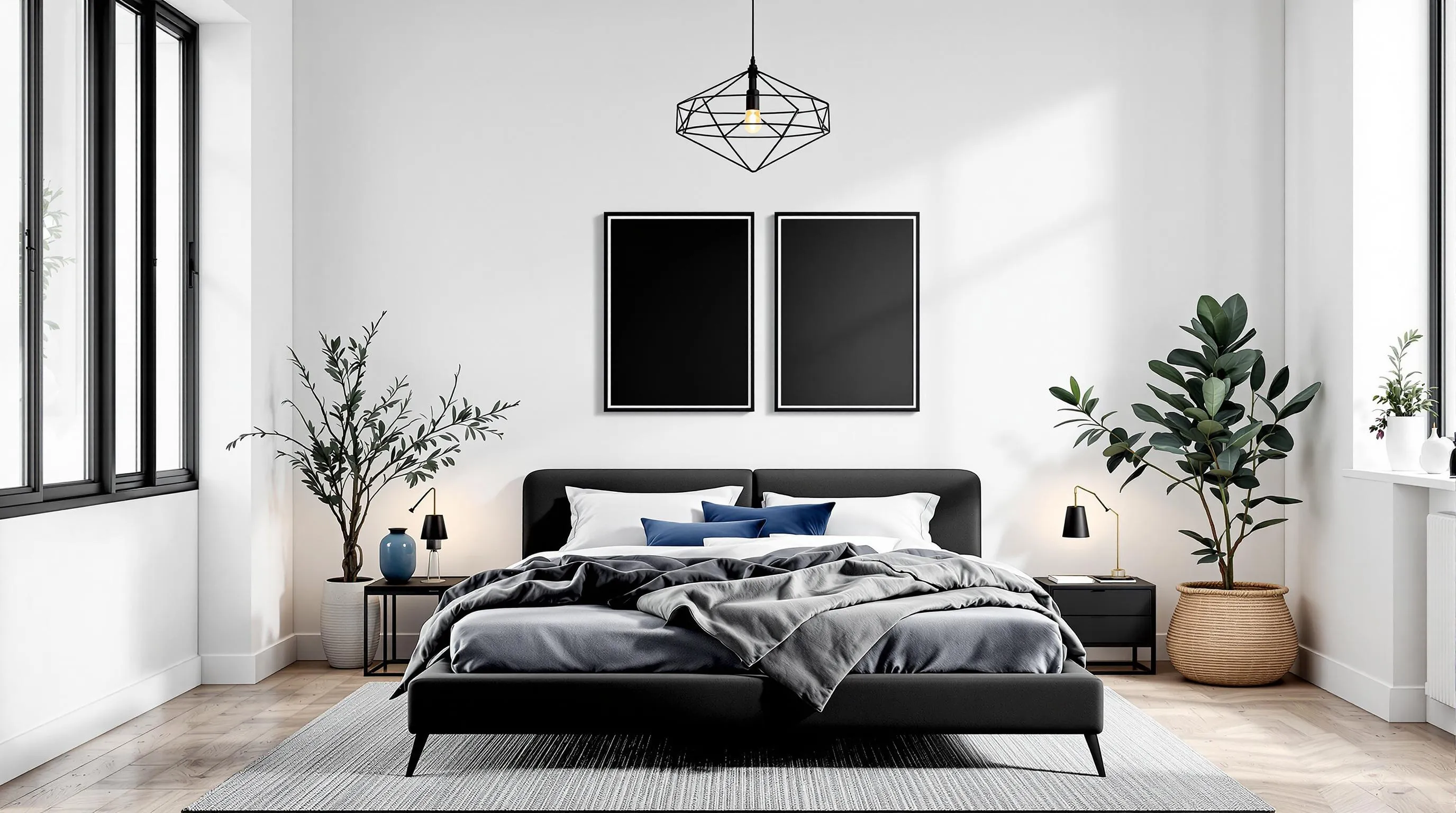
Black accents introduce essential depth and visual interest to minimalist bedrooms while maintaining the clean, uncluttered aesthetic. When used thoughtfully, these striking elements create sophisticated focal points that enhance the overall design without compromising simplicity.
Using Black Strategically Without Overwhelming the Space
For successful minimalist bedrooms, we recommend limiting black to less than 10% of the room’s surfaces to maintain balance. Strategic placement of black elements—such as a sleek bed frame, geometric light fixture, or picture frames—creates powerful visual anchors without dominating the space. Pairing these accents with textured materials like linen or natural wood effectively softens the intensity of black elements. Matte black finishes work particularly well in minimalist settings, reducing glare and preserving the room’s tranquil atmosphere. Consider incorporating small black accents through decorative objects, light switches, or hardware that add definition without overwhelming the neutral backdrop.
Black and White Combinations for Classic Minimalism
A monochromatic black and white palette emphasizes clean lines and architectural details, creating the quintessential minimalist aesthetic. White walls paired with black trim or window frames achieve timeless contrast that feels both fresh and sophisticated. Soft whites like Farrow & Ball’s “Borrowed Light” combined with charcoal accessories create a balanced environment that remains visually interesting. For added dimension, we suggest introducing subtle depth through muted blue tones such as Farrow & Ball’s “De Nimes” or gentle greens as accent colors. These subtle additions prevent the space from feeling flat while maintaining minimalist principles. Create rhythm throughout the room by repeating black elements at different heights—perhaps through a floor lamp, side table, and wall art—to guide the eye naturally through the space.
Selecting Monochromatic Color Schemes for Ultimate Simplicity
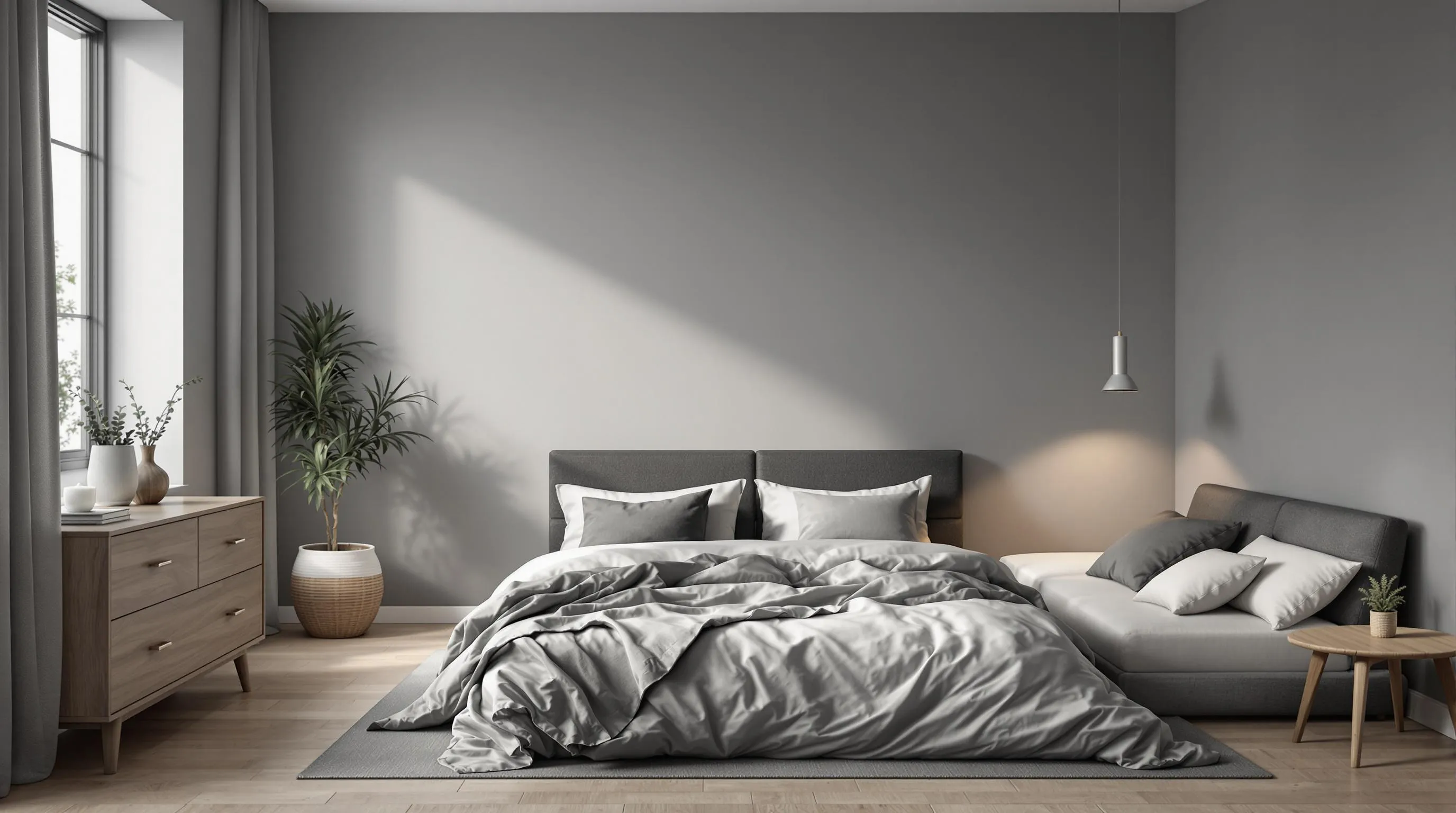
Monochromatic color schemes represent the essence of minimalist design, using various shades and tints of a single color to create a cohesive and harmonious space. This approach eliminates visual clutter while maintaining visual interest through subtle variations in tone.
Understanding the Power of Single-Color Palettes
Monochromatic designs harness different shades of the same color to create depth without complexity. A white-based scheme might incorporate pure white walls, off-white bedding, and cream-colored accessories for subtle dimension. Using various tones of gray—from pale silver to charcoal—can establish a sophisticated atmosphere that feels both cohesive and layered. The beauty of this approach lies in its ability to emphasize simplicity while avoiding the flatness that sometimes accompanies minimalist spaces.
Creating Depth with Tonal Variations
To carry out an effective monochromatic scheme, focus on incorporating at least three different tones of your chosen color. For beige palettes, combine pale beige walls with medium-toned linen curtains and darker taupe accents for visual hierarchy. When working with gray schemes, light gray bedding paired with medium gray walls and charcoal furniture creates natural visual flow. Varying the intensity of your chosen color prevents the room from feeling one-dimensional while preserving the clean, uncluttered aesthetic essential to minimalism.
Balancing Texture in Single-Color Rooms
Texture becomes particularly important in monochromatic bedrooms to prevent the space from feeling flat. Introduce varied textural elements through different fabrics and materials while staying within your color family. Soft cotton sheets, nubby wool throws, and smooth ceramic lamps in similar shades of white can create tactile interest without disrupting visual calm. Adding matte and glossy finishes of the same color—such as flat wall paint alongside high-gloss furniture—creates subtle contrast that enhances the monochromatic palette without sacrificing minimalist principles.
Incorporating Natural Elements for Warmth
Natural materials add essential warmth to monochromatic minimalist bedrooms. Light wood elements complement beige and taupe schemes while providing organic texture and visual interest. Stone accessories in varying gray tones blend seamlessly into gray monochromatic spaces, adding earthy authenticity. These natural elements prevent monochromatic schemes from feeling sterile or impersonal while maintaining the serene, uncluttered environment that defines minimalist design.
Using Light to Enhance Monochromatic Spaces
Lighting dramatically affects how monochromatic colors appear throughout the day. Morning light may highlight the cooler undertones in a white scheme, while evening light brings out warmer elements. Position mirrors strategically to reflect light and enhance the perceived depth of your monochromatic palette. Using dimmers allows for adjusting the intensity of light, which can dramatically alter how your single-color scheme reads—brighter settings emphasize variations in tone, while softer lighting blends the colors more seamlessly.
How to Test and Choose the Perfect Minimalist Bedroom Color

Sample Multiple Swatches
Testing several color options is essential before committing to your minimalist palette. We recommend selecting 3-4 neutral shades and applying them to your walls in different areas. Observe these samples under both natural daylight and artificial evening lighting to see how they transform throughout the day. Many colors that appear perfect on small paint chips can look dramatically different when applied to larger wall surfaces, revealing undertones you might not have initially noticed.
Assess Material Textures
Texture integration plays a crucial role in minimalist bedroom design. We’ve found that evaluating how your chosen colors interact with various materials prevents your space from feeling flat or lifeless. Try placing fabric swatches, wood samples, and textile examples against your potential wall colors. Notice how linen bedding looks against soft beige, or how natural wood furnishings complement warm taupe tones. This practice ensures your minimalist palette maintains visual interest even though its simplicity.
Experiment with Accent Colors
Adding small touches of color helps personalize your minimalist space without overwhelming it. We suggest introducing potential accent colors through easily changeable items like throw pillows, small art pieces, or decorative objects. Muted blues, soft greens, or blush pinks can add subtle depth when used sparingly. Limit your accent palette to 1-2 colors maximum to maintain the clean, uncluttered aesthetic that defines minimalist design.
Conduct a Declutter Simulation
Temporarily removing non-essential items from your bedroom provides valuable insight into how your color choices affect the space. Clear surfaces, remove decorative elements, and simplify bedding to mimic a truly minimalist environment. This simulation helps you evaluate how your potential colors impact perceived spaciousness and tranquility. Colors often appear more prominent and impactful in simplified spaces, making this step crucial for accurate decision-making.
Consider Finish Options
Finish selection significantly impacts the overall feel of your minimalist bedroom. We strongly recommend prioritizing matte or low-sheen finishes for walls and large surfaces to reduce glare and maintain serenity throughout your space. Glossy finishes can create distracting reflections that detract from the calm atmosphere you’re aiming to create. Eggshell finishes offer a practical middle ground, providing subtle depth while remaining easy to clean.
Limit Your Overall Palette
Cohesion is fundamental to successful minimalist design. Restrict your total color palette to 2-3 base colors with just 1-2 accent hues for maximum impact. This disciplined approach ensures your space remains visually calm while still offering enough variety to feel inviting rather than sterile. Many professional designers recommend starting with a dominant neutral like white, gray, or beige, then adding secondary neutrals and minimal accents for a perfectly balanced minimalist bedroom.
Conclusion: Creating Your Ideally Colored Minimalist Retreat
The perfect minimalist bedroom color palette isn’t just about following trends—it’s about creating a space that feels authentically yours while maintaining clean simplicity. Whether you’re drawn to pure whites soft beiges or strategic black accents your choices should reflect both your personal style and minimalist principles.
Remember that texture plays as vital a role as color in preventing minimalist spaces from feeling flat or sterile. Testing colors in your actual space under different lighting conditions will always yield better results than relying solely on inspiration photos.
By thoughtfully selecting your palette and limiting it to 2-3 base colors with minimal accents you’ll create a bedroom that feels both intentionally designed and effortlessly peaceful—a true minimalist retreat that welcomes you at the end of each day.
Frequently Asked Questions
What is minimalist bedroom design?
Minimalist bedroom design focuses on creating a clean, uncluttered space using simple elements and a restrained color palette. It emphasizes functionality, essential furniture, and thoughtful curation of items to create a peaceful environment. The style balances simplicity with personal touches, resulting in a serene space that promotes relaxation and rest without visual distractions.
What are the best neutral colors for a minimalist bedroom?
The best neutral colors for minimalist bedrooms include classic white, soft beige, warm gray, greige (gray-beige blend), soft black, and pale taupe. Each offers unique benefits: white creates openness, beige adds warmth, gray provides sophistication, greige adapts to changing light, soft black creates dramatic accents, and taupe delivers subtle warmth while maintaining the minimalist aesthetic.
How can I use white in my minimalist bedroom without it feeling sterile?
Add texture through varied textiles like light drapes, flat-weave rugs, and upholstered furniture in soft neutrals. Layer materials such as linen, cotton, and wool to create visual interest. Incorporate natural fibers and materials to enhance warmth and character. Consider using off-whites rather than pure whites, and include subtle organic elements for a sophisticated yet inviting space.
How can I incorporate gray into a minimalist bedroom design?
Use light gray to amplify natural light for an airy feel or dark gray for drama and sophistication. Create depth through monochromatic layering with various gray shades. Pair gray with warm neutrals like beige or terracotta to add coziness. Consider muted earth tones such as sage green or dusty blue as complementary colors. Gray works as an excellent backdrop for minimalist furniture with clean lines.
What warm neutral colors work well in minimalist bedrooms?
Beige, cream, and taupe create cozy yet clean foundations for minimalist bedrooms. These warm neutrals enhance spaciousness while adding subtle depth. They pair beautifully with white, gray, and natural wood tones. For best results, combine these neutrals with natural textures like linen bedding, jute rugs, or wooden furniture to add warmth without visual clutter.
Can I use color in a minimalist bedroom?
Yes, you can incorporate color through subtle, muted tones. Soft blues like powder blue or dusty periwinkle create tranquility. Organic greens such as sage and mint bring natural elements indoors. Earth tones like terracotta and clay offer grounded warmth. The key is using these colors intentionally as small accents through bedding, curtains, or decorative items while maintaining a predominantly neutral palette.
How do I incorporate black accents in a minimalist bedroom?
Limit black elements to less than 10% of the room’s surfaces to maintain balance. Use black strategically for focal points like bed frames, lighting fixtures, or window frames. Pair black with soft whites for a classic minimalist look that emphasizes clean lines. Consider charcoal as a softer alternative to pure black. Add dimension with subtle accent colors like muted blues or greens.
What is a monochromatic color scheme and how does it work in minimalist design?
A monochromatic color scheme uses various shades and tints of a single color to create a cohesive space. Include at least three different tones of your chosen color to create depth. This approach eliminates visual clutter while maintaining interest through subtle variations. Enhance a monochromatic scheme with different textures and materials to add dimension without disrupting the minimalist aesthetic.
How do I test colors before committing to a minimalist bedroom palette?
Sample multiple swatches of 3-4 neutral shades on your walls and observe them in different lighting conditions throughout the day. Assess how colors interact with existing materials and furniture. Experiment with accent colors through easily changeable items like pillows or throws. Conduct a declutter simulation to evaluate how color choices impact perceived spaciousness. Consider finish options, preferring matte or low-sheen for serenity.
How many colors should I use in a minimalist bedroom?
Limit your palette to 2-3 base colors and 1-2 accent hues for a cohesive minimalist design. This restrained approach creates harmony while preventing visual overwhelm. Focus on variations within a color family rather than contrasting colors. The limited palette helps maintain the clean, uncluttered aesthetic that defines minimalist design while still allowing for personalization and visual interest.

